More on this book
Community
Kindle Notes & Highlights
in some ways, aesthetics is the ultimate design problem. Aesthetics involves human emotion—and we’ve discovered that when emotions are involved, design thinking has proved to be the best problem-solving tool.
Designing your life doesn’t involve a clear goal, like creating hinges that last five years, or building a giant bridge that will safely connect to landmasses; those are engineering problems, in which you can get hard data on your options and engineer the one best solution. When you have a desired outcome (a truly portable laptop computer, a sexy-looking sports car, or a well-designed life) but no clear solution in sight, that’s when you brainstorm, try crazy stuff, improvise, and keep “building your way forward” until you come up with something that works.
A well-designed life is a life that is generative—it is constantly creative, productive, changing, evolving, and there is always the possibility of surprise. You get out of it more than you put in.
It has been our experience, in office hour after office hour, that people waste a lot of time working on the wrong problem. If they are lucky, they will fail miserably quickly and get forced by circumstance into working on better problems. If they are unlucky and smart, they’ll succeed—we call it the success disaster—and wake up ten years later wondering how the hell they got to wherever they are, and why they are so unhappy.
People fight reality. They fight it tooth and nail, with everything they’ve got. And anytime you are arguing or fighting with reality, reality will win. You can’t outsmart it. You can’t trick it. You can’t bend it to your will.
We have just three questions for you: What is your name? What is your quest? What is the airspeed velocity of an unladen swallow? If you’re like most people, it was probably easy to answer two of those three questions. We all know our names, and a simple Google search can give us the other answer—twenty-four miles per hour.
The essence of play is being fully immersed and joyful in what you’re doing, without being constantly distracted by concerns about the outcomes.
The truth is that all of us have more than one life in us. When we ask our students, “How many lifetimes’ worth of living are there in you?,” the average answer is 3.4. And if you accept this idea—that there are multiple great designs for your life, though you’ll still only get to live one—it is rather liberating.
Now, we love the prefrontal cortex and wouldn’t be caught in public without it, but we don’t want it taking our ideas hostage prematurely. If we can get out into the wild idea space, then we know we’ve overcome premature judgment.
Our minds are generally lazy and like to get rid of problems as quickly as possible, so they surround first ideas with a lot of positive chemicals to make us “fall in love” with them. Do not fall in love with your first idea. This relationship almost never works out.
Good prototypes isolate one aspect of a problem and design an experience that allows you to “try out” some version of a potentially interesting future.
a prototype is not a thought experiment; it must involve a physical experience in the world. The data to make good decisions are found in the real world, and prototyping is the best way to engage that world and get the data you need to move forward.
We tend to start all of our life design brainstorms with the phrase “How many ways can we think of to…” to make sure that we haven’t limited our potential output.
In life design, the choosing process has four steps. First you gather and create some options, then you narrow down your list to your top alternatives, then you finally choose, and then, last but not least, you…agonize over that choice. Agonize over whether you’ve done the right thing. In fact, we encourage you to spend countless hours, days, months, or even decades agonizing. Just kidding.
It turns out that reversibility is not conducive to establishing reliable happiness with a decision. Apparently, just the invitation to reconsider and “keep your options open” makes us doubt and devalue our choice.
Failure is just the raw material of success.
When we say we can’t do this alone, we don’t just mean that we’d like to do it ourselves but we’re insufficient, so we have to go get some helpers. What we mean is that life design is intrinsically a communal effort.
Community is more than just sharing resources or hanging out now and then. It’s showing up and investing in the ongoing creation of one another’s lives. Being in that kind of community is a great way to live, and we highly recommend it as an ongoing practice, not just when making big plans or starting new things.
What makes an effective community is not having people in it with the right expertise or information. What makes it work is people with the right intention and presence.


